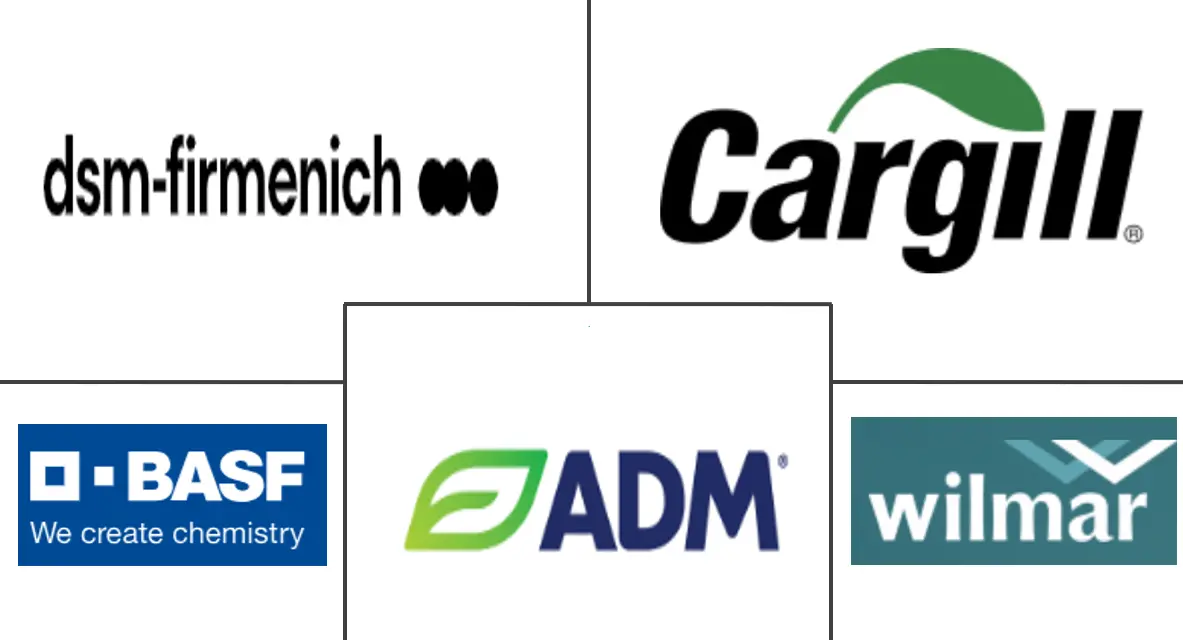Mixed Tocopherols Market Size and Share
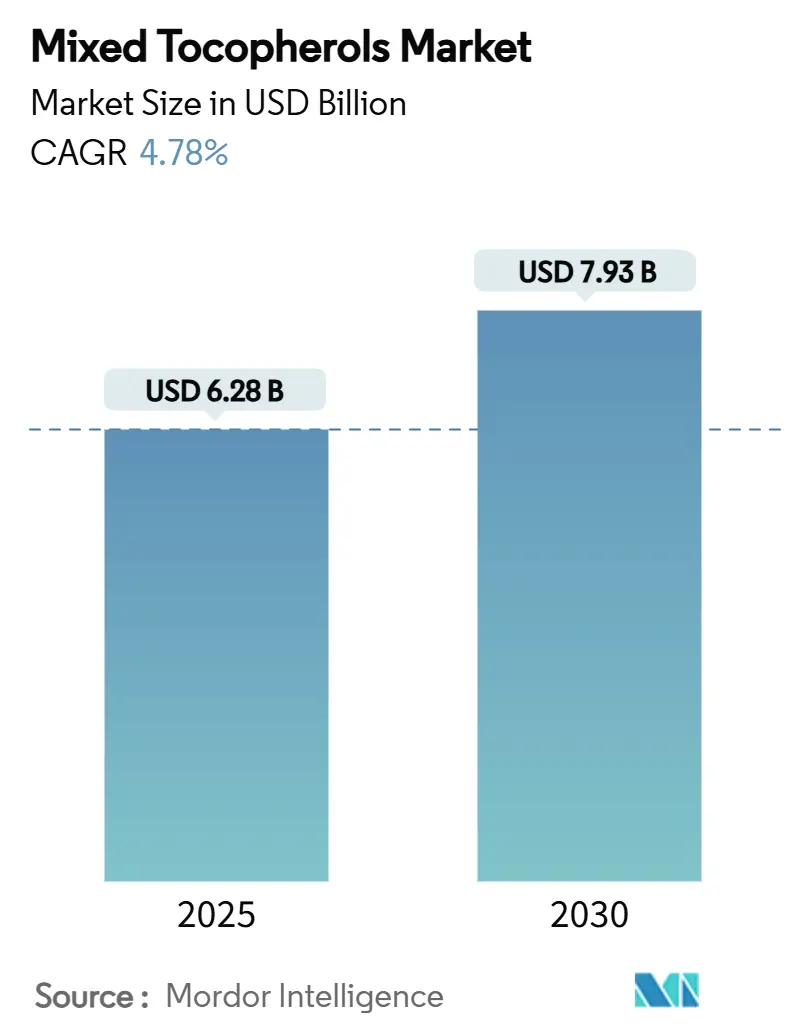
Mixed Tocopherols Market Analysis by Mordor Intelligence
The mixed tocopherols market size is expected to grow from USD 6.28 billion in 2025 to USD 7.93 billion by 2030, at a CAGR of 4.78% during the forecast period. The market growth is driven by increasing clean-label regulations, higher demand for natural antioxidants in food, supplements, and cosmetics industries, and improved extraction technologies that increase yields while maintaining purity. Food manufacturers are transitioning from synthetic preservatives like BHA/BHT, while dietary supplement companies are developing premium vitamin E formulations. Cosmetics manufacturers are integrating tocopherols into natural beauty products to address consumer safety concerns. North America maintains market leadership due to its advanced processing capabilities and strict FDA regulations, while the Asia-Pacific region demonstrates the highest growth rate, supported by increased supplement consumption and alignment with Western regulatory standards.
Key Report Takeaways
- By source, soybean oil led with 46.58% of mixed tocopherols market share in 2024, whereas sunflower oil is forecast to post the highest 6.25% CAGR through 2030.
- By compound, alpha-rich grades commanded 43.26% share of the mixed tocopherols market size in 2024, while gamma-rich variants are set to expand at a 7.59% CAGR to 2030.
- By form, powder accounted for 67.71% share of the mixed tocopherols market in 2024; granules/gel formulations record the fastest 6.93% CAGR between 2025-2030.
- By application, food and beverage held 41.83% share of the mixed tocopherols market in 2024, whereas cosmetics and personal care exhibit the strongest 8.42% CAGR through 2030.
- By geography, North America dominated with 33.09% of mixed tocopherols market share in 2024, while Asia-Pacific is projected to experience the highest 5.76% CAGR over 2025-2030.
Global Mixed Tocopherols Market Trends and Insights
Drivers Impact Analysis
| Driver | (~) % Impact on CAGR Forecast | Geographic Relevance | Impact Timeline |
|---|---|---|---|
| Growing demand for natural antioxidants/preservatives | +1.2% | Global, with concentration in North America and Europe | Medium term (2-4 years) |
| Regulatory and industry shift toward clean-label, plant-derived ingredients | +0.9% | North America and Europe, expanding to Asia-Pacific | Long term (≥ 4 years) |
| Growth of processed and packaged food industry | +0.8% | Asia-Pacific core, spill-over to Middle East and Africa | Medium term (2-4 years) |
| Rising popularity of dietary supplements | +0.7% | Global, led by North America and Asia-Pacific | Short term (≤ 2 years) |
| Shift from synthetic BHA/BHT to natural antioxidants in pet food | +0.5% | North America and Europe | Short term (≤ 2 years) |
| Surging adoption in personal care and cosmetics industry | +0.4% | Global, with early gains in North America, Europe, Asia-Pacific | Medium term (2-4 years) |
| Source: Mordor Intelligence | |||
Growing Demand for Natural Antioxidants/Preservatives
The shift toward natural antioxidants is driven by increasing consumer health awareness and stricter regulatory requirements across food applications. Consumers increasingly associate "natural" ingredients with health benefits, affecting their purchasing decisions in processed and functional food categories. According to the International Food Information Council, in 2024, nearly 26% of U.S. respondents identified "Natural" as their primary definition of healthy food[1]Source: International Food Information Council, "2024 IFIC Food & Health SURVEY," ific.org. This consumer perception has prompted manufacturers to replace synthetic additives with natural alternatives like mixed tocopherols. Regulatory changes at state and federal levels are reshaping the market. West Virginia has implemented a ban on synthetic preservatives, while Virginia has restricted their use in public school meals[2]Source: Gardner, an FDA Law Firm, "State Food Additive Bans Signal a Shift in Regulatory Priorities," gardner.law. The FDA has established a national timeline to eliminate petroleum-based synthetic dyes. These regulatory changes create market opportunities for mixed tocopherols, particularly in institutional food service sectors with urgent compliance requirements. The market expansion includes aquaculture applications, as USDA organic standards now allow tocopherols in fish feed for oxidation prevention during transport, broadening the market beyond traditional livestock applications.
Regulatory and Industry Shift Toward Clean-Label, Plant-Derived Ingredients
Regulatory changes in clean-label requirements are transforming from voluntary guidelines to mandatory compliance frameworks, affecting ingredient sourcing strategies across food and personal care industries. The FDA's enhanced GRAS process requires comprehensive scientific evidence for self-affirmed substances, especially in children's food products, creating significant advantages for natural antioxidants with established safety documentation. The regulatory shift creates supply chain implications as manufacturers pursue vertically integrated tocopherol sources to maintain traceability and quality control throughout the production process. Advanced extraction methods using supercritical CO2 and enzymatic pretreatment have become essential technological requirements rather than optional upgrades, as they deliver the purity levels needed for regulatory compliance while remaining cost-competitive with synthetic alternatives.
Growth of Processed and Packaged Food Industry
The global processed and packaged food industry expansion drives the increasing demand for mixed tocopherols. Food manufacturers prefer these natural antioxidants as they extend shelf life and support clean-label initiatives, especially in products prone to oxidation such as snacks, cereals, sauces, oils, and ready-to-eat meals. With consumers seeking convenient food options, manufacturers face pressure to maintain product stability without using synthetic preservatives like BHA or BHT. Mixed tocopherols present a natural alternative with demonstrated effectiveness and regulatory acceptance in both U.S. and EU markets. Consumer dietary patterns increasingly incorporate processed and packaged foods, strengthening this trend. Ayana Bio's 2023 report indicates that 82% of adults include ultra-processed foods in their diets, highlighting this category's significance in current food consumption[3]Source: Ayana Bio, "SURVEY DATA REVEALS TWO-THIRDS OF AMERICAN ADULTS WOULD EAT MORE AND PAY MORE FOR ULTRA-PROCESSED FOODS THAT INCLUDE MORE NUTRITIOUS INGREDIENTS," ayanabio.com. This widespread consumption increases the requirement for effective natural preservation methods to maintain product quality during storage, shipping, and retail display.
Rising Popularity of Dietary Supplements
Dietary supplement consumption patterns reveal sophisticated consumer segmentation that extends beyond basic vitamin E supplementation to targeted health applications. Regulatory frameworks continue to adapt to support this diversification, with the FDA establishing tolerance exemptions for vitamin E compounds when used as inert ingredients in pesticide formulations, indicating broader acceptance of tocopherol applications across agricultural and food systems. The supplement sector's growth trajectory intersects with technological innovations in bioavailability enhancement, where microencapsulation techniques using electrohydrodynamic methods improve vitamin E stability and controlled release profiles for cosmetic and nutraceutical applications. These technological advancements enable manufacturers to differentiate their products through superior bioavailability claims while maintaining natural ingredient positioning in the market.
Restraints Impact Analysis
| Restraint | (~) % Impact on CAGR Forecast | Geographic Relevance | Impact Timeline |
|---|---|---|---|
| Price volatility of vegetable-oil distillates | -0.8% | Global, with acute impact in Brazil and United States | Short term (≤ 2 years) |
| Intense competition from synthetic antioxidants | -0.6% | Global, particularly in cost-sensitive applications | Medium term (2-4 years) |
| Supply-chain risk from soybean acreage shifts in Brazil and United States | -0.5% | Global supply chain, originating from Brazil andUnited States | Medium term (2-4 years) |
| Stability challenges in certain high-temperature or acidic formulation | -0.3% | Global, affecting specific application segments | Long term (≥ 4 years) |
| Source: Mordor Intelligence | |||
Price Volatility of Vegetable-Oil Distillates
The price volatility of vegetable-oil distillates key raw materials for extracting mixed tocopherols poses a significant constraint on market growth. These distillates, obtained from the refining of soybean, sunflower, canola, and corn oils, experience price fluctuations due to climate variations, geopolitical events, and changes in global trade dynamics. The increasing use of vegetable oils in biodiesel production creates additional upward pressure on feedstock prices and supply availability. When prices for these distillates surge, the cost of tocopherol production rises accordingly, reducing profit margins and market competitiveness against synthetic antioxidants. This price instability affects food, supplement, and feed manufacturers' ability to maintain consistent costs, causing some to reduce or postpone the adoption of natural tocopherols in favor of more price-stable alternatives.
Intense Competition from Synthetic Antioxidants
Synthetic antioxidants remain competitive despite regulatory challenges, particularly in cost-sensitive applications where performance requirements are prioritized over clean-label preferences. These synthetic options maintain advantages in high-temperature applications where tocopherol stability is limited, creating market opportunities for manufacturers to develop heat-stable natural formulations. Competition is strong in emerging markets where price sensitivity is high and regulatory standards are less stringent than in developed markets. Manufacturers are responding with hybrid solutions that combine mixed tocopherols with other natural antioxidants to match synthetic alternatives' performance while maintaining natural positioning. Additionally, technological advancements in microencapsulation and chemical modification are improving tocopherol stability without compromising their natural status.
Segment Analysis
By Source: Soybean Oil Dominance Faces Sunflower Challenge
Soybean oil maintains its commanding position with 46.58% market share in 2024, while sunflower oil demonstrates the highest growth trajectory at 6.25% CAGR through 2030. Rapeseed oil maintains a strategic middle position, offering balanced tocopherol composition with 120.3 mg/kg alpha-tocopherol and 122.0 mg/kg gamma-tocopherol. Corn oil contains the highest gamma-tocopherol concentration at 259.7 mg/kg, making it particularly suitable for pet food and industrial applications.
Enzymatic pretreatment methods now achieve over 90% tocopherol recovery from deodorizer distillates, significantly outperforming traditional methods' 50% efficiency. This technological advancement particularly benefits sunflower oil processing, where higher initial tocopherol concentrations combine with improved extraction efficiency to deliver superior economics. Manufacturers are actively diversifying their sources to build supply chain resilience against geopolitical risks and climate-related production disruptions.
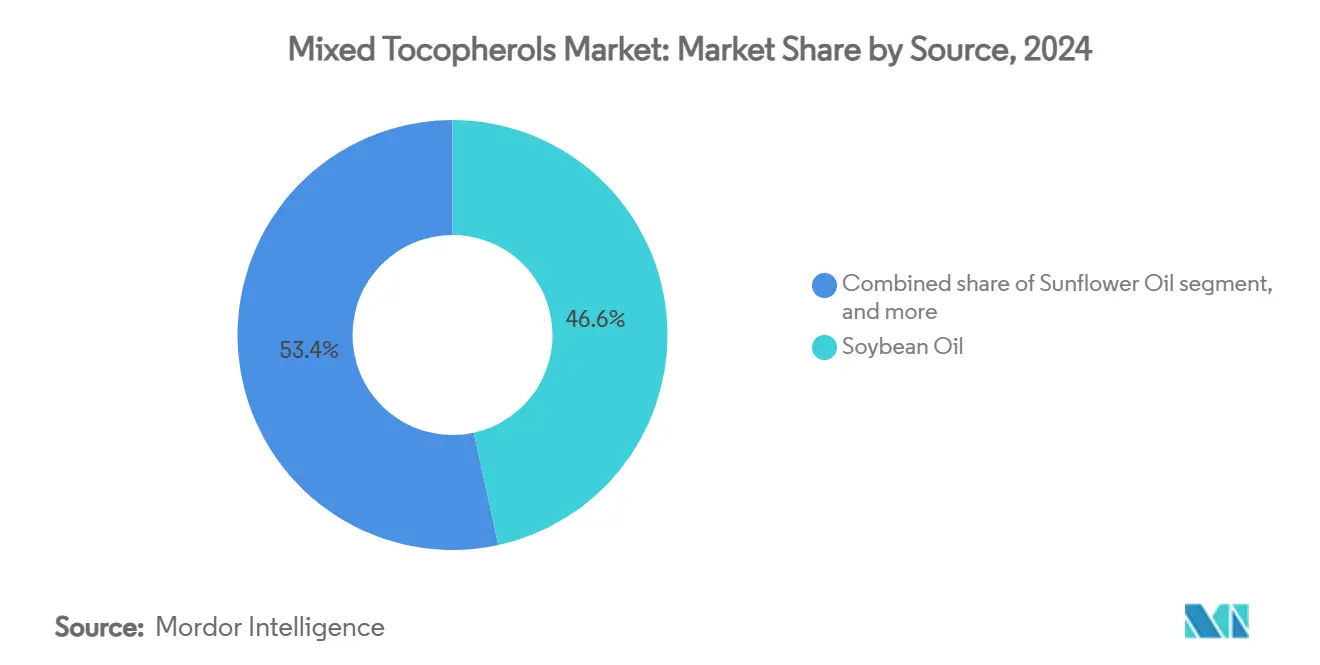
Note: Segment shares of all individual segments available upon report purchase
By Compound: Alpha-Rich Formulations Lead Despite Gamma-Rich Acceleration
Alpha-rich tocopherols hold a 43.26% market share in 2024, maintaining their dominant position in dietary supplements and cosmetics applications where vitamin E activity is essential and paramount. These compounds are particularly valued for their high biological activity and proven efficacy in human nutrition. Gamma-rich tocopherols are projected to grow at a 7.59% CAGR through 2030, due to their unique anti-inflammatory properties and superior antioxidant effectiveness in specific food applications. Their rising popularity stems from extensive research demonstrating their role in preventing oxidative stress and supporting cardiovascular health.
Beta-rich and delta-rich tocopherols serve specialized market segments, with delta-tocopherol particularly valued for its stability in acidic formulations and beta-tocopherol providing intermediate properties for custom blending applications. These variants offer specific molecular advantages in food preservation and specialized pharmaceutical formulations. Custom tocopherol blends represent emerging opportunities where specific ratios are formulated to achieve optimal antioxidant performance, allowing manufacturers to target precise stability and nutritional requirements across different applications.
By Form: Powder Dominance Challenged by Granules Innovation
Powder form dominates the market with a 67.71% share in 2024, primarily due to its superior handling characteristics, cost-effectiveness, and proven effectiveness in supplement manufacturing and food fortification where precise dosing and stability are essential. The powder format enables manufacturers to maintain consistent quality control, achieve uniform distribution in final products, and ensure extended shelf life. Granules/gel formulations are growing at a 6.93% CAGR through 2030, supported by their enhanced performance in high-temperature processing and improved bioavailability in cosmetic applications. These formats offer advantages in controlled release properties and enhanced stability in complex formulations.
Liquid formulations serve specific applications requiring immediate bioavailability, particularly in premium cosmetics and therapeutic products where rapid absorption and precise dosing are crucial. The evolution of form segmentation aligns with the industry's focus on application-specific optimization, as manufacturers develop targeted delivery systems to enhance tocopherol effectiveness across diverse end-use applications. The market continues to diversify as manufacturers leverage delivery system optimization to gain competitive advantages, investing in research and development to create innovative formulation technologies that address specific industry requirements.
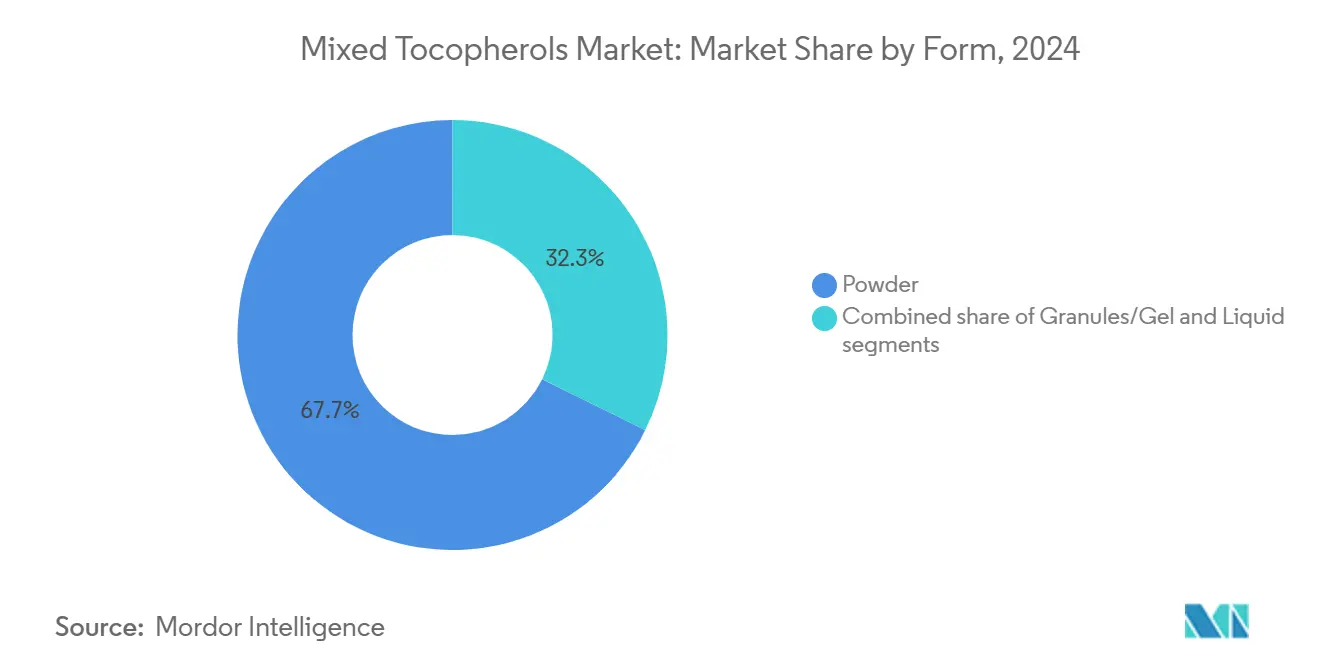
Note: Segment shares of all individual segments available upon report purchase
By Application: Food Leadership Faces Cosmetics Disruption
Food and beverage applications dominate the market with a 41.83% share in 2024, driven by increasing demand for natural preservatives in processed foods and functional beverages. The cosmetics and personal care segment shows the highest growth rate at 8.42% CAGR through 2030, as consumers increasingly seek natural alternatives to synthetic antioxidants in skincare products and cosmetic formulations. Animal feed applications maintain steady demand due to regulations restricting synthetic antioxidants, particularly in livestock and poultry feed production.
The dietary supplements segment grows due to increased health awareness and specific therapeutic uses, including heart health, immune support, and anti-aging applications. The pharmaceutical segment commands premium prices due to strict tocopherol purity and stability requirements, especially in drug formulations and medical supplements. Improved extraction and formulation technologies enable tocopherols to serve multiple end-use categories effectively, from food preservation to cosmetic stability enhancement. The market continues to evolve as manufacturers develop specialized formulations for specific applications, with new opportunities emerging in aquaculture feed additives and premium pet food segments beyond traditional uses.
Geography Analysis
North America holds 33.09% market share in 2024, supported by strict regulations favoring natural antioxidants and sophisticated food processing infrastructure. The region's established supply chains connect Midwest soybean production to East Coast processing facilities. California's Low Carbon Fuel Standard increases demand for vegetable oil feedstocks, generating tocopherol-rich distillates as co-products. The region maintains cost competitiveness through advanced extraction technologies while meeting purity standards. Canada's rapeseed oil production provides balanced tocopherol profiles for specialized applications, while Mexico's expanding processed food sector increases demand for natural antioxidants.
Asia-Pacific demonstrates the highest growth rate at 5.76% CAGR through 2030, driven by increased dietary supplement consumption and regulatory harmonization with Western standards. China's growth stems from urbanization-related processed food consumption. India's nutraceutical market expands through the Food Safety and Standards Act, which categorizes vitamin E as food ingredients, enabling broader food fortification and supplement applications. Japan's health food system and South Korea's Health Functional Food Act provide regulatory frameworks that support market development.
Europe maintains a strong market position through its cosmetics and personal care industries, which require natural antioxidants for premium formulations. EFSA's safety assessment of tocopherol-rich extracts provides clear usage guidelines, maintaining the Tolerable Upper Intake Level at 300 mg/day for adults. The Middle East and Africa present growth opportunities as economic development and urbanization increase processed food consumption, creating demand for natural antioxidants that maintain product quality in challenging climates.
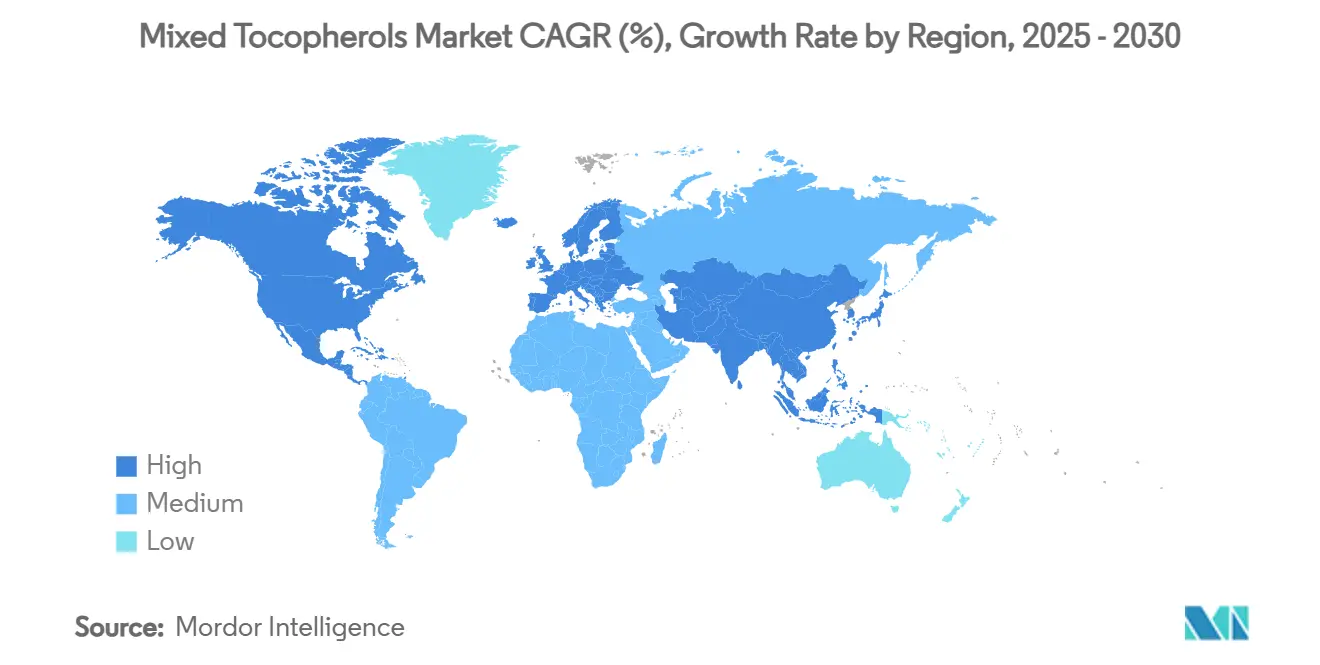
Competitive Landscape
The mixed tocopherols market shows moderate concentration, with opportunities for technological advancement and vertical integration among established companies and new entrants. The competitive environment increasingly focuses on supply chain management, as renewable diesel production creates competition for vegetable oil feedstocks. This has prompted tocopherol manufacturers to either secure dedicated crushing capacity or develop new extraction technologies that can process lower-grade materials while meeting purity requirements.
Companies now prioritize application-specific development, creating specialized delivery systems and compound profiles that enhance effectiveness in specific end-use categories, moving beyond simple price-based competition. Patent developments in water-soluble vitamin E derivatives and microencapsulation systems provide competitive advantages to companies that can deliver improved bioavailability and stability.
New market opportunities exist in specialized applications, including aquaculture feed additives and cosmetic formulations. Companies with appropriate technical capabilities and market positioning can gain advantages through early entry into these segments. The market continues to evolve as regulations favor natural antioxidants, creating opportunities for companies that can manage approval processes while maintaining operational efficiency and competing effectively against synthetic alternatives.
Mixed Tocopherols Industry Leaders
-
BASF SE
-
DSM-Firmenich N.V.
-
Archer Daniels Midland (ADM)
-
Cargill Inc.
-
Wilmar International Ltd.
- *Disclaimer: Major Players sorted in no particular order

Recent Industry Developments
- April 2025: Kensing LLC introduced Sun E, a clean-label, non-GMO tocopherol derived from upcycled sunflower oil by-products. Sun E contains over 90% RRR-α-tocopherol, the most biologically active isomer, and is extracted without chemical modifications. The product offers approximately double the bioavailability compared to synthetic vitamin E. Sun E®holds Non-GMO Project certification and complies with EU deforestation regulations.
- March 2025: Louis Dreyfus Company (LDC) launched a new plant-based vitamin E product line at Food Ingredients China 2025. The line includes mixed tocopherols and their acetate and succinate derivatives. This initiative aligns with LDC's strategy to expand its value-added, plant-based ingredients portfolio for food, pharmaceutical, and cosmetic applications.
- April 2024: Cosphatec GmbH released Cosphaderm Tocopharin, a natural antioxidant blend containing mixed tocopherols, carnosic acid from rosemary, and organic sunflower oil. The product protects cosmetic formulations and skin from oxidative stress. Cosphaderm Tocopharin is COSMOS- and NATRUE-compliant, vegan, non-GMO, and palm oil-free. In vitro studies showed that at 0.1% concentration, the product effectively stabilizes oils and reduces reactive oxygen species in skin cells, performing better than traditional mixed tocopherols and synthetic antioxidants like BHT.
Global Mixed Tocopherols Market Report Scope
| Soybean Oil |
| Rapeseed Oil |
| Sunflower Oil |
| Corn Oil |
| Others |
| Alpha-Rich Tocopherols |
| Beta-Rich Tocopherols |
| Gamma-Rich Tocopherols |
| Delta-Rich Tocopherols |
| Other Blends |
| Liquid |
| Powder |
| Granules/Gel |
| Food and Beverage |
| Animal Feed |
| Dietary Supplements |
| Pharmaceuticals |
| Cosmetics and Personal Care |
| North America | United States |
| Canada | |
| Mexico | |
| Rest of North America | |
| Europe | Germany |
| France | |
| United Kingdom | |
| Spain | |
| Italy | |
| Russia | |
| Rest of Europe | |
| Asia-Pacific | China |
| India | |
| Japan | |
| Australia | |
| Thailand | |
| Rest of Asia-Pacific | |
| South America | Brazil |
| Argentina | |
| Rest of South America | |
| Middle East and Africa | United Arab Emirates |
| South Africa | |
| Rest of Middle East and Africa |
| By Source | Soybean Oil | |
| Rapeseed Oil | ||
| Sunflower Oil | ||
| Corn Oil | ||
| Others | ||
| By Compound | Alpha-Rich Tocopherols | |
| Beta-Rich Tocopherols | ||
| Gamma-Rich Tocopherols | ||
| Delta-Rich Tocopherols | ||
| Other Blends | ||
| By Form | Liquid | |
| Powder | ||
| Granules/Gel | ||
| By Application | Food and Beverage | |
| Animal Feed | ||
| Dietary Supplements | ||
| Pharmaceuticals | ||
| Cosmetics and Personal Care | ||
| By Geography | North America | United States |
| Canada | ||
| Mexico | ||
| Rest of North America | ||
| Europe | Germany | |
| France | ||
| United Kingdom | ||
| Spain | ||
| Italy | ||
| Russia | ||
| Rest of Europe | ||
| Asia-Pacific | China | |
| India | ||
| Japan | ||
| Australia | ||
| Thailand | ||
| Rest of Asia-Pacific | ||
| South America | Brazil | |
| Argentina | ||
| Rest of South America | ||
| Middle East and Africa | United Arab Emirates | |
| South Africa | ||
| Rest of Middle East and Africa | ||
Key Questions Answered in the Report
What is the current size of the mixed tocopherols market?
The mixed tocopherols market size stands at USD 6.28 billion in 2025 and is projected to reach USD 7.93 billion by 2030.
Which region leads the mixed tocopherols market?
North America leads with 33.09% share in 2024, driven by stringent FDA regulations and advanced processing infrastructure.
Which source segment is growing the fastest?
Sunflower-derived mixed tocopherols exhibit the highest 6.25% CAGR to 2030 due to superior alpha-tocopherol content.
Why are gamma-rich tocopherols gaining popularity?
Gamma-rich variants deliver strong anti-inflammatory and nitrogen-radical-scavenging properties, spurring a 7.59% CAGR through 2030.
Page last updated on:
